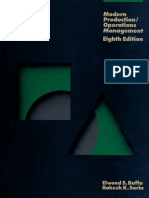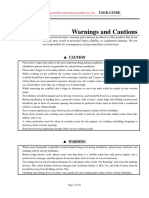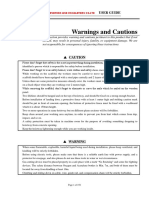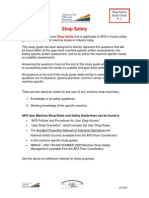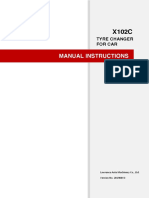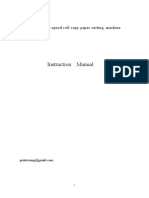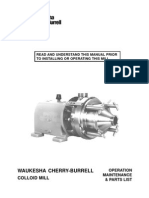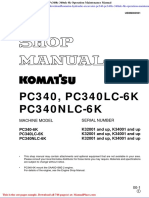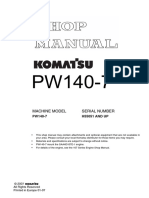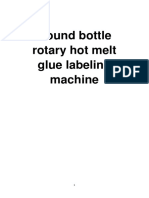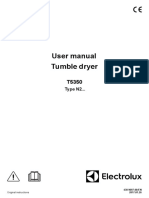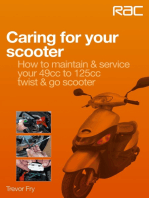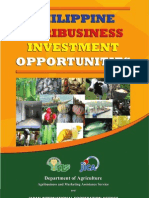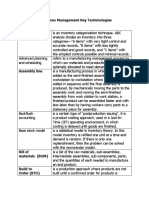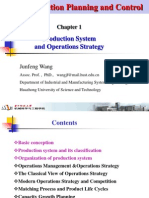Title: Factory Guideline: Item Ref Task Description Related Documents Section 1.0 1.00 Task For All Sections
Title: Factory Guideline: Item Ref Task Description Related Documents Section 1.0 1.00 Task For All Sections
Uploaded by
kayumanggiCopyright:
Available Formats
Title: Factory Guideline: Item Ref Task Description Related Documents Section 1.0 1.00 Task For All Sections
Title: Factory Guideline: Item Ref Task Description Related Documents Section 1.0 1.00 Task For All Sections
Uploaded by
kayumanggiOriginal Description:
Original Title
Copyright
Available Formats
Share this document
Did you find this document useful?
Is this content inappropriate?
Copyright:
Available Formats
Title: Factory Guideline: Item Ref Task Description Related Documents Section 1.0 1.00 Task For All Sections
Title: Factory Guideline: Item Ref Task Description Related Documents Section 1.0 1.00 Task For All Sections
Uploaded by
kayumanggiCopyright:
Available Formats
Title: Factory Guideline
Item 1.0 Ref 1.00 Task for All Sections 1.01 Proper handling of glasses must be observed to avoid accident and damage of materials. Refer to WAE glass handling guidelines for more specific details. All All All All All All All All All All All All All All All All Task Description Related Documents Section
1.02 Appropriate gloves should be used in handling glasses No glass is allowed to be processed without job card unless otherwise instructed by the production or the operations manager. All job orders must be reviewed properly as soon as it was received from the office in order to raise any question and 1.04 possible difficulties as early as possible. All job orders must be reviewed properly in advance in order to raise possible shortage or unavailability of materials or 1.05 machine parts such as drill bits, grinding belts, etc. All job orders must be reviewed properly in advance and raise any requirement that may be needed from the customer 1.06 such as U-channels, templates, shutter frames, etc. 1.03 Material's stock must be regularly checked and updated with store keeper to avoid future difficulties or peoblems. 1.07 Immediately raise to the production manager any possible shortage of materials. (Example: silicone for double glazing, PVB for Lamination, paint for screen printing, etc.) All production, quality, maintenance, safety, management instructions or guidelines released in a form of letters, memos or guideline must be strictly followed. The working area must be maintained clean all the time. Daily cleaning of machineries and working area must be done 1.09 within 20mins from the start of each shift. Do not mix glasses in an A-frame / trolley. It is very important not to mix good glasses with rejected glasses in one A1.10 frame or trolley. 1.08 1.11 Fix a sign at the front of each A-frame / trolley indicating what are the glasses stacked on that A-frame. All necessary information must be mentioned such as job order number, customer name, glass type, date of production, etc.
1.12 Each glass must have proper sticker or label fixed on it. 1.13 Each glass must be separated by cork pads. There must be enough cork pads affixed on the glass. Each cork pads should be separated around 500mm apart.
1.14 Used cork pads should be collected and recycled. 1.15 1.16 In transporting A-frames or trolleys containing glasses, the glasses should be tightened by belts. The glasses should not be moving while in transport. Transporting glasses stacked in an A-frame or trolleys should be done slowly and carefully. Do not stack too many glasses in an A-frame or trolley. Always maintain the weight of the glasses in an A-frame to maximum 2.2 Tons. All A-frames or trolleys must be ready prior to processing in order to avoid production stop due to unavailability of Aframes or trolleys. During production, if the A-frame wherein the finished product are being stacked are nearly full, there must be a new empty A-frame or trolley available near the fully loaded A-frame to replace it immediately. It should not take a long time to replace a new A-frame or trolley. Glasses which are planned to be processed should be placed near the loading area of the process. There must be no production stop due to the arranging of the glasses to be processed once the production starts. All section must secure signature from the responsible personnel of the succeeding section upon their receipt of the finished glasses as a proof that they received that particular number of glasses to avoid loss of glasses.
1.17
All
1.18
All
1.19 1.20
All All All All All All
Laborers are not allowed to leave their respective areas without the approval of their section leader. Only one person at a time is allowed to leave their station. The start of the shift is 7:00 AM for day and 7:00 PM at night. The workers and foremen must be on their respective 1.21 section at the start of their shift sharp. At the end of each shift, the workers are not allowed to leave their respective stations until the end of shift has been 1.22 reached. The production must not stop until the shift is finish. 1.23 Labors are not allowed to carry any electronic devices inside the factory such as mobile phones, radio, ear phones, etc. No production stop is allowed without the approval of the production manager or the operations manager. Anything that 1.24 may affect productivity such as testings, machine checking, etc. should not be done without the approval of the production manager. 1.25 All machineries ahould be handled, used and operated as per the machine guideline or operating procedures. In case of encountering machine / equipment problem or breakdown, the leader of the line (foreman) must immediately prepare a repairing request to be submitted to the production manager and the maintenance manager. Always wear appropriate personal protective equipmets (PPE) such as safety shoes, gloves, safety helmet, arm pad, goggles, etc. The worker must wear the PPE properly. Incorrect way of using the PPE is subject for disciplinary action.
All
1.26
All
1.27 1.28
All All All
All glasses being produced must be within the specified criteria. WAE is issuing an in-house quality criteria relevant to the inductry standard or the project specification. Rejected glasses which are to be claimed to the supplier should be separated and managed properly. Each rejected 1.29 glasses should be reported and must have the QC rejection label. The A-frame / trolley containing the rejected glasses should be properly labeled.
Title: Factory Guideline
Item Ref Task Description Rejected glasses for re-work should be separated and managed properly. Each rejected glasses should be reported and must have the QC rejection label. The A-frame / trolley containing the rejected glasses should be properly labeled. Related Documents Section
1.30
All
Rejected glasses for disposal should be separated and managed properly. Each rejected glasses should be reported and 1.31 must have the QC rejection label. The A-frame / trolley containing the rejected glasses should be properly labeled. No glass is allowed to be disposed without securing approval from the QC engineers and the production manager. 1.32 2.0 Any glass for re-work such as scratch removing, IGU opening, etc. must not be done without the approval of the QC engineers and the production manager.
All
All
2.00 Storage Section (Glass and Other Materials) 2.01 Glass sheets planned for production must be arranged and prepared in advance prior to processing. Arranging of glass sheets must not be a reason for production stop since this has to be arranged ahead of time. Always check the cutting quality (Dimension, edge quality, thickness, etc.). It is very important that any nonconformances or rejections should be spotted immediately to avoid further processing of defected glasses. Cutting Process
2.02
Cutting Process
3.0
3.00 Cutting Process (Manual and Computer Cutting) 3.01 3.02
To be Monitored By
Responsible Person
Prod'n Engr & Gen. Foreman Prod'n Engr & Gen. Foreman Prod'n Engr & Gen. Foreman Prod'n Engr & Gen. Foreman Prod'n Engr & Gen. Foreman Prod'n Engr & Gen. Foreman Prod'n Engr & Gen. Foreman Prod'n Engr & Gen. Foreman Prod'n Engr & Gen. Foreman Prod'n Engr & Gen. Foreman Prod'n Engr & Gen. Foreman Prod'n Engr & Gen. Foreman Prod'n Engr & Gen. Foreman Prod'n Engr & Gen. Foreman Prod'n Engr & Gen. Foreman Prod'n Engr & Gen. Foreman Prod'n Engr & Gen. Foreman
Foremen Foremen Foremen Foremen Foremen Foremen Foremen Foremen Foremen Foremen Foremen Foremen Foremen Foremen Foremen Foremen
Foremen
Prod'n Engr & Gen. Foreman Prod'n Engr & Gen. Foreman Prod'n Engr & Gen. Foreman Prod'n Engr & Gen. Foreman Prod'n Engr & Gen. Foreman Prod'n Engr & Gen. Foreman Prod'n Engr & Gen. Foreman Maintenance, Prod'n Engr & Gen. Foreman Maintenance, Prod'n Engr & Gen. Foreman Maintenance, Prod'n Engr & Gen. Foreman QC, Prod'n Engr & Gen. Foreman QC, Prod'n Engr & Gen. Foreman
Foremen
Foremen Foremen Foremen Foremen Foremen Foremen
Foremen
Foremen
Foremen Foremen Foremen
To be Monitored By QC, Prod'n Engr & Gen. Foreman QC, Prod'n Engr & Gen. Foreman QC, Prod'n Engr & Gen. Foreman
Responsible Person Foremen
Foremen
Foremen
Prod'n Engr & Gen. Foreman QC, Prod'n Engr & Gen. Foreman
Foreman
Foreman
You might also like
- How to Rebuild & Modify Ford C4 & C6 Automatic TransmissionsFrom EverandHow to Rebuild & Modify Ford C4 & C6 Automatic TransmissionsRating: 5 out of 5 stars5/5 (5)
- Operations Management Knec NotesDocument55 pagesOperations Management Knec NotesAlex MartineNo ratings yet
- 1 - Ad-R Series - User ManualDocument76 pages1 - Ad-R Series - User Manualaldariz201181100% (1)
- GM Automatic Overdrive Transmission Builder's and Swapper's GuideFrom EverandGM Automatic Overdrive Transmission Builder's and Swapper's GuideRating: 4.5 out of 5 stars4.5/5 (8)
- Modern ProductionOperations Management (Elwood S. Buffa and Rakesh K. Sarin)Document856 pagesModern ProductionOperations Management (Elwood S. Buffa and Rakesh K. Sarin)Indah AswadiNo ratings yet
- Manual InglesDocument34 pagesManual InglessergirojasNo ratings yet
- Ricoh 4055 PDFDocument1,280 pagesRicoh 4055 PDFPham Nguyen Hoang Minh100% (1)
- 176 - Manual Advantage Lab AL02-01 & AL02-05 & AL02-07 Rev00Document55 pages176 - Manual Advantage Lab AL02-01 & AL02-05 & AL02-07 Rev00ermanno100% (1)
- Operating Instruction Manual: HFTF-70T Automatic Tilt Thermoforming MachineDocument72 pagesOperating Instruction Manual: HFTF-70T Automatic Tilt Thermoforming MachineAnderson VillamizarNo ratings yet
- Sanyo User Manul-2012 VersionDocument158 pagesSanyo User Manul-2012 VersionAliRouyou67% (12)
- TM 5 2430 200 24Document1,491 pagesTM 5 2430 200 24Advocate100% (1)
- CNC Machining Certification Exam Guide: Setup, Operation, and ProgrammingFrom EverandCNC Machining Certification Exam Guide: Setup, Operation, and ProgrammingNo ratings yet
- Lean Manufacturing Tools Techniques and How To Use ThemDocument245 pagesLean Manufacturing Tools Techniques and How To Use Themhugoferto100% (38)
- Welder Practice Questions: Welder Practice Questions Similar to Red Seal or AWS Welder ExamFrom EverandWelder Practice Questions: Welder Practice Questions Similar to Red Seal or AWS Welder ExamNo ratings yet
- PW130 S UEBM001201 PW130ES-6kDocument643 pagesPW130 S UEBM001201 PW130ES-6kCompaire Compairee100% (13)
- PW160-7K S 0411Document890 pagesPW160-7K S 0411ado_22100% (4)
- Oaw 5.0 - 5 Tonne Winch User ManualDocument46 pagesOaw 5.0 - 5 Tonne Winch User Manualtspaes75% (4)
- Komatsu D37EX-21 Bulldozer Service Repair Manual SN 5001 and Up PDFDocument23 pagesKomatsu D37EX-21 Bulldozer Service Repair Manual SN 5001 and Up PDFfhsjekkdmmeNo ratings yet
- Shop Manual WB146 5Document200 pagesShop Manual WB146 5edgardo-ehq100% (7)
- Production and Operations ManagementDocument3 pagesProduction and Operations ManagementMargel Airon Theo75% (4)
- TR 40 Instruction ManualDocument46 pagesTR 40 Instruction ManualLe Du100% (1)
- SANYO USER MANUL-2012 VersionDocument158 pagesSANYO USER MANUL-2012 VersionAngel Iglesias100% (2)
- Sanyo User Manul 2012 VersionDocument158 pagesSanyo User Manul 2012 Versionoro plataNo ratings yet
- Manual de Instalacion Ascensor Sanyo 1Document30 pagesManual de Instalacion Ascensor Sanyo 1Reina Yadyra Chasi CansingNo ratings yet
- Ace Classic Lt-20 Im-03 20-Jun-06Document101 pagesAce Classic Lt-20 Im-03 20-Jun-06chidambaram kasi100% (2)
- PC240LC, 240NLC-6K - K32001 and - Up PC210, 210LC-6K - K32001 and upEEBD001801Document665 pagesPC240LC, 240NLC-6K - K32001 and - Up PC210, 210LC-6K - K32001 and upEEBD001801josephvanbac75% (4)
- Wa115-3 Vebm120100Document174 pagesWa115-3 Vebm120100Augusto Oliveira100% (2)
- Radial Drilling Machine HandbookDocument66 pagesRadial Drilling Machine Handbookcentaury2013100% (1)
- APS SafetyDocument8 pagesAPS SafetyBLUE TOOTHNo ratings yet
- Manual Fuji YidaDocument140 pagesManual Fuji Yidajeferson_camilo100% (1)
- X102C Tyre Changer Manual LawrenceDocument27 pagesX102C Tyre Changer Manual LawrenceMichael NgadionoNo ratings yet
- Pc16olc 7KDocument676 pagesPc16olc 7KCinthya CollaguazoNo ratings yet
- PC78MR-6 Sebm030601Document592 pagesPC78MR-6 Sebm030601Augusto Oliveira95% (20)
- DTCP-A4 High-Speed Roll Copy Paper Cutting Machine Instruction Manual PDFDocument40 pagesDTCP-A4 High-Speed Roll Copy Paper Cutting Machine Instruction Manual PDFA.Magied Mahmoud100% (2)
- Manual de InstruçãoDocument124 pagesManual de InstruçãojhonnyymossNo ratings yet
- HM300-1L A1000 CEBM015200.PDF-páginas-1-398,400-401,403-1236Document1,234 pagesHM300-1L A1000 CEBM015200.PDF-páginas-1-398,400-401,403-1236Emmanuel HernandezNo ratings yet
- Komatsu Wheeled Excavators Pw148 8 Shop ManualDocument20 pagesKomatsu Wheeled Excavators Pw148 8 Shop Manuallaura100% (39)
- S MPC 550015019Document727 pagesS MPC 550015019Ravinder SinghNo ratings yet
- Komatsu Wheeled Excavators Pw140 7 Shop ManualDocument20 pagesKomatsu Wheeled Excavators Pw140 7 Shop ManualBarbara100% (57)
- SDLG1Document428 pagesSDLG1Lukman ExmesNo ratings yet
- Ebook - Komatsu Pw140-7 Shop Manual1-Đã M KhóaDocument1,144 pagesEbook - Komatsu Pw140-7 Shop Manual1-Đã M KhóaLâm Trần ngọc100% (1)
- TY-1500.2R说明书 Chapter - 1 (1,2)Document73 pagesTY-1500.2R说明书 Chapter - 1 (1,2)Anonymous i0SMnrONo ratings yet
- Vortex - MANUAL ERS11ExDocument43 pagesVortex - MANUAL ERS11ExLinas KarčiauskasNo ratings yet
- SM PC4000-6 8152 SMPC40008152Document822 pagesSM PC4000-6 8152 SMPC40008152David Colan Palacios100% (3)
- 95-03028 Colloidmill WCBDocument24 pages95-03028 Colloidmill WCBNga PhiNo ratings yet
- HPC Extreme 330 ManualDocument26 pagesHPC Extreme 330 Manualods13 FilNo ratings yet
- CK6150 CNC Lathe Operation ManualDocument24 pagesCK6150 CNC Lathe Operation Manualyahyaebrahim.no3No ratings yet
- Komatsu Hydraulic Excavator Pc340 Pc340lc 340nlc 6k Operation Maintenance ManualDocument20 pagesKomatsu Hydraulic Excavator Pc340 Pc340lc 340nlc 6k Operation Maintenance Manualbonnie98% (46)
- Installation, Operation Manual: BJW2500 Reagent Agitation TankDocument26 pagesInstallation, Operation Manual: BJW2500 Reagent Agitation Tank翟庆祥No ratings yet
- German VEBM400101 PW180-7E0 CSS-Net 2008-11-11 PDFDocument1,180 pagesGerman VEBM400101 PW180-7E0 CSS-Net 2008-11-11 PDFMichał Bujara100% (4)
- ZMQPDocument36 pagesZMQPDavid CordovaNo ratings yet
- Manual Fuji Yida PDFDocument140 pagesManual Fuji Yida PDFMoran Martines100% (1)
- VALUE-100 User ManualDocument23 pagesVALUE-100 User ManualHelder FuenmayorNo ratings yet
- Vortex Scroll Compressor O&s Manual 2013Document21 pagesVortex Scroll Compressor O&s Manual 2013Jesse Honkanen100% (1)
- Benassi User's Manual RL7 05-05GBDocument14 pagesBenassi User's Manual RL7 05-05GBm.kelleci7248No ratings yet
- Bản Sao Của Emailing PW148!8!1Document1,158 pagesBản Sao Của Emailing PW148!8!1Trung LêNo ratings yet
- V-20i Machine Instruction ManualDocument70 pagesV-20i Machine Instruction ManualsunhuynhNo ratings yet
- VEBM410100 - PW140 7 - CSS Net - 2007 01 25Document1,106 pagesVEBM410100 - PW140 7 - CSS Net - 2007 01 25Michał BujaraNo ratings yet
- Opp ENGLISHDocument42 pagesOpp ENGLISHDániel CLNo ratings yet
- User Manual t5350Document20 pagesUser Manual t5350mayNo ratings yet
- BuWa SZF Manual Globe-Valves EN-1Document11 pagesBuWa SZF Manual Globe-Valves EN-1Diego VerlyNo ratings yet
- Caring for your scooter: How to maintain & service your 49cc to 125cc twist & go scooterFrom EverandCaring for your scooter: How to maintain & service your 49cc to 125cc twist & go scooterNo ratings yet
- PlanDocument1 pagePlankayumanggiNo ratings yet
- OEEDocument23 pagesOEEkayumanggiNo ratings yet
- Complete Philippines Agribusiness BrochureDocument49 pagesComplete Philippines Agribusiness Brochurekayumanggi100% (2)
- TKE Sequence For Phase 2Document1 pageTKE Sequence For Phase 2kayumanggiNo ratings yet
- CE Marking On GlassDocument44 pagesCE Marking On GlasskayumanggiNo ratings yet
- The ToyotaDocument25 pagesThe ToyotaShahidul Haque PalashNo ratings yet
- MGT6206 Group Assignment-1Document8 pagesMGT6206 Group Assignment-1Lyu JingNo ratings yet
- Welcome To The Homepage For: Simquick: Process Simulation With Excel Second EditionDocument3 pagesWelcome To The Homepage For: Simquick: Process Simulation With Excel Second Editiondarwin_hua0% (1)
- Cainta Subjects Offered 3t1819Document30 pagesCainta Subjects Offered 3t1819Erlyn Grace RedobladoNo ratings yet
- POM J8 Location DecisionsDocument34 pagesPOM J8 Location DecisionsTelle MarieNo ratings yet
- Ba4102 Management ConceptDocument56 pagesBa4102 Management ConceptrinshadpppmNo ratings yet
- Management Through MoviesDocument42 pagesManagement Through MoviesUNNATI AGRAWALNo ratings yet
- Bicycle Assembly Line GameDocument7 pagesBicycle Assembly Line GameIvan TomasevicNo ratings yet
- Nigel Slack Chapter 4 Process DesignDocument31 pagesNigel Slack Chapter 4 Process DesignEneng Lestari100% (2)
- Case Study No.2 Analysis On Toyota's Operations ManagementDocument3 pagesCase Study No.2 Analysis On Toyota's Operations Managementzarah mae aday50% (2)
- Vision Mission: Principal: Dr. N. V. Raghavendra, Professor, Mech. DeptDocument57 pagesVision Mission: Principal: Dr. N. V. Raghavendra, Professor, Mech. DeptPrakhar PiyushNo ratings yet
- Example Midterm Exam 1 Polimi OperationsDocument2 pagesExample Midterm Exam 1 Polimi OperationsMarce Tabares HerreraNo ratings yet
- Cookery 12 Combined Modules Q2 Week 2Document19 pagesCookery 12 Combined Modules Q2 Week 2Rhynz BanastonNo ratings yet
- Quantitative Management Techniques in Operations ManagementDocument12 pagesQuantitative Management Techniques in Operations ManagementJohn HughesNo ratings yet
- Project Report On MORE Retail Aditya Birla GroupDocument24 pagesProject Report On MORE Retail Aditya Birla GroupPratik PatilNo ratings yet
- Chapter 1 OMDocument18 pagesChapter 1 OMAbdufettah JemalNo ratings yet
- Mba Zg623tDocument20 pagesMba Zg623tshashank_khatri3728No ratings yet
- Guide To Supply Chain Management RemediationV2Document26 pagesGuide To Supply Chain Management RemediationV2Andrada-DianaFilipciucNo ratings yet
- Introduction To Operations Management: Mcgraw-Hill/IrwinDocument15 pagesIntroduction To Operations Management: Mcgraw-Hill/IrwinMd MonirNo ratings yet
- Operations Management TerminologiesDocument20 pagesOperations Management TerminologiesKyle MedranoNo ratings yet
- chap1-01 Production System and Operations Strategy 王峻峰Document43 pageschap1-01 Production System and Operations Strategy 王峻峰SiddiqiNo ratings yet
- Lean MaintenanceDocument48 pagesLean MaintenanceJoaquim Reis100% (1)
- Sample CH 01Document29 pagesSample CH 01Ali Akbar0% (1)
- Unit I Introduction To Operations ManagementDocument60 pagesUnit I Introduction To Operations Management2arunagiri0% (1)
- Chapter 17 - INventoryDocument39 pagesChapter 17 - INventorymaheshwari.vas.25No ratings yet
- Exam 2 Study GuideDocument11 pagesExam 2 Study GuideAnonymous ewJy7jyvNNo ratings yet




